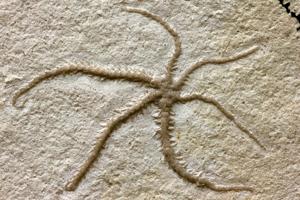
By Dean Murray via SWNS
An incredible 155-million-year-old fossil shows a starfish-like creature cloning itself.
The brittle star – a relative of starfish – was frozen in time as it regenerated half of its body.
A new study describes the world-first find of a specimen displaying so-called six-fold symmetry and clonal fragmentation, in which an organism produces genetically identical offspring by breaking off parts of its own body and regrowing them.
Co-author Dr. Ben Thuy, a paleontologist at Luxembourg’s Musée national d’histoire naturelle, says: “Some brittle stars and starfish have an unusual way of reproduction: they split in halves and regrow the missing body parts.
“While the biology of this process called clonal fragmentation is relatively well studied, virtually nothing is known about its evolutionary origin.”
Dr. Thuy says the international team of paleontologists was “extremely lucky” to find the 155-million-years old six-armed brittle star, petrified in the process of regenerating one body half.
He says: “This specimen provides compelling evidence that clonal fragmentation in star-shaped echinoderms has deep evolutionary roots and that it has been linked to life on a host and a six-fold symmetry since the Jurassic.”
The new species described in the paper, named Ophiactis hex, was discovered in limestone during a 2018 excavation in southern Germany.
The paper concludes: “Ophiactis hex seems to represent the first fossil case of a fissiparous ophiuroid. It suggests that clonal fragmentation, combined with six-fold symmetry and an epizoic lifestyle, was established as a means of asexual reproduction in ophiuroids by the Late Jurassic.”



